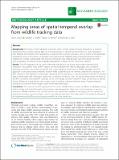Mapping areas of spatial-temporal overlap from wildlife tracking data
Abstract
Background The study of inter-individual interactions (often termed spatial-temporal interactions, or dynamic interactions) from remote tracking data has focused primarily on identifying the presence of such interactions. New datasets and methods offer opportunity to answer more nuanced questions, such as where on the landscape interactions occur. In this paper, we provide a new approach for mapping areas of spatial-temporal overlap in wildlife from remote tracking data. The method, termed the joint potential path area (jPPA) builds from the time-geographic movement model, originally proposed for studying human movement patterns. Results The jPPA approach can be used to delineate sub-areas of the home range where inter-individual interaction was possible. Maps of jPPA regions can be integrated with existing geographic data to explore landscape conditions and habitat associated with spatial temporal-interactions in wildlife. We apply the jPPA approach to simulated biased correlated random walks to demonstrate the method under known conditions. The jPPA method is then applied to three dyads, consisting of fine resolution (15 minute sampling interval) GPS tracking data of white-tailed deer (Odocoileus virginianus) collected in Oklahoma, USA. Our results demonstrate the ability of the jPPA to identify and map jPPA sub-areas of the home range. We show how jPPA maps can be used to identify habitat differences (using percent tree canopy cover as a habitat indicator) between areas of spatial-temporal overlap and the overall home range in each of the three deer dyads. Conclusions The value of the jPPA approach within current wildlife habitat analysis workflows is highlighted along with its simple and straightforward implementation and interpretation. Given the current emphasis on remote tracking in wildlife movement and habitat research, new approaches capable of leveraging both the spatial and temporal information content contained within these data are warranted. We make code (in the statistical software R) for implementing the jPPA approach openly available for other researchers.
Citation
Long , J , Webb , S , Nelson , T & Gee , K 2015 , ' Mapping areas of spatial-temporal overlap from wildlife tracking data ' , Movement Ecology , vol. 3 . https://doi.org/10.1186/s40462-015-0064-3
Publication
Movement Ecology
Status
Peer reviewed
ISSN
2051-3933Type
Journal article
Description
The collection of the deer data used in this study was supported by funding from The Samuel Roberts Noble Foundation, Inc.Collections
Items in the St Andrews Research Repository are protected by copyright, with all rights reserved, unless otherwise indicated.

